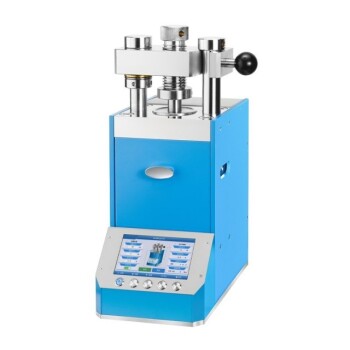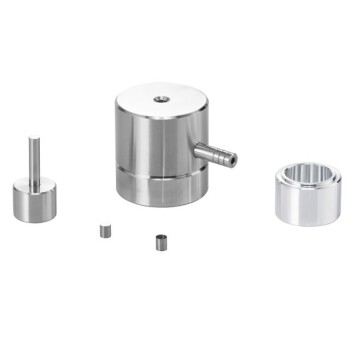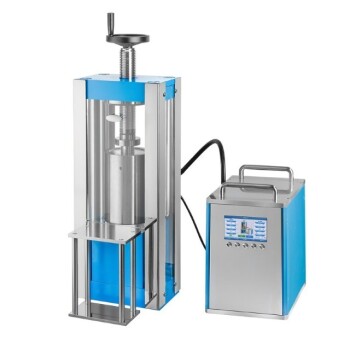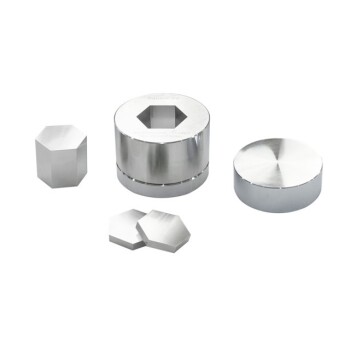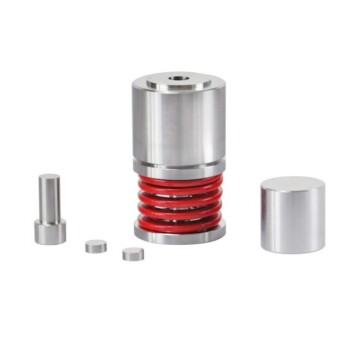At their core, manual hydraulic presses represent a fundamental trade-off between cost and consistency. Their primary advantage is a significantly lower initial investment, making them an excellent choice for laboratories with limited budgets or infrequent sample preparation needs. The main disadvantages, however, are their reliance on physical operator effort and the resulting lack of repeatable pressure application from one sample to the next.
A manual hydraulic press is a cost-effective and durable tool for basic sample preparation. The decision to use one hinges on whether your workflow can tolerate operator-dependent variability in exchange for a lower initial investment and simpler maintenance.
How a Manual Hydraulic Press Operates
A manual hydraulic press generates force through a straightforward and robust mechanical system, making it a staple in many labs for preparing solid samples.
The Core Mechanism
The press uses a hand-operated pump or lever to pressurize hydraulic oil within a sealed cylinder. This pressure acts on a piston, which moves to compress the sample material placed on its surface.
Controlling the Force
An operator applies force by physically pumping the lever. A pressure gauge provides a visual readout of the applied force, allowing the user to monitor and adjust the pressure until the desired level is reached.
Common Laboratory Applications
These presses are most frequently used to prepare compressed powder samples for analysis. Common examples include creating KBr pellets for FTIR spectroscopy or forming sample pellets for X-Ray Fluorescence (XRF) analysis.
The Primary Advantage: Cost-Effectiveness
The most compelling reason to choose a manual press is its economic efficiency, especially when sample preparation is not a daily, high-volume task.
Lower Initial Investment
Manual hydraulic presses are significantly more affordable than their automatic counterparts. This makes them accessible to labs with tighter budgets or for applications where a more expensive, automated system cannot be justified.
Ideal for Infrequent Use
For labs that only prepare samples occasionally, a manual press is a highly practical choice. The higher cost and complexity of an automated system provide little benefit if the equipment sits idle most of the time.
Simple Maintenance
With fewer moving parts and no complex electronics, manual presses are generally easier and cheaper to maintain. Their simple, durable construction ensures a long service life with minimal upkeep.
Understanding the Trade-offs and Limitations
While cost-effective, the manual nature of the press introduces critical limitations that must be considered for any serious analytical work.
The Challenge of Repeatability
The most significant disadvantage is the lack of consistent pressure application. The final pressure depends entirely on the operator, and it is nearly impossible for a person to apply the exact same force profile every time.
This variability can be a critical source of error in sensitive analytical techniques where sample density and uniformity are paramount.
The Demand for Physical Effort
Operating the press requires significant physical effort, especially to reach higher pressures. This can lead to operator fatigue, which further increases the inconsistency between samples.
For labs processing multiple samples, this manual work becomes labor-intensive and inefficient.
Unsuitability for High-Throughput
The hands-on, one-at-a-time nature of a manual press makes it completely unsuitable for high-throughput environments. Automated systems are designed for this purpose, offering unattended operation for dozens of samples.
Manual vs. Automatic: A Clear Comparison
The choice between a manual and automatic press comes down to a clear distinction between budget, volume, and the need for precision.
The Case for Manual
A manual press is the right tool when budget is the primary constraint, sample volume is low, and the downstream analysis can tolerate minor variations in sample preparation.
The Case for Automatic
An automatic press is essential for high-throughput workflows or any application demanding the highest level of accuracy and repeatability. It eliminates operator error, ensuring every sample is prepared under identical conditions.
Making the Right Choice for Your Lab
Your decision depends entirely on balancing your budget against your specific requirements for precision, consistency, and throughput.
- If your primary focus is budget and low-volume work: A manual press is the most logical and cost-effective choice for your needs.
- If your primary focus is analytical precision and repeatability: An automatic press is a necessary investment to ensure sample consistency and eliminate operator-induced variables.
- If your primary focus is high-throughput screening: A manual press is not a viable option; an automated system is required to handle the workload efficiently.
By understanding this fundamental trade-off between economy and precision, you can confidently select the right tool for your specific scientific goals.
Summary Table:
| Aspect | Advantages | Disadvantages |
|---|---|---|
| Cost | Lower initial investment, affordable for tight budgets | Higher long-term costs if precision is needed |
| Operation | Simple maintenance, durable construction | Requires physical effort, operator-dependent variability |
| Performance | Suitable for low-volume, infrequent use | Lack of repeatability, unsuitable for high-throughput |
Need the perfect lab press for your workflow? KINTEK specializes in lab press machines, including automatic lab presses, isostatic presses, and heated lab presses, designed to deliver precise, repeatable results for laboratories. Whether you're handling low-volume tasks or high-throughput demands, our solutions enhance efficiency and accuracy. Contact us today to discuss your needs and discover how we can support your lab's success!
Visual Guide
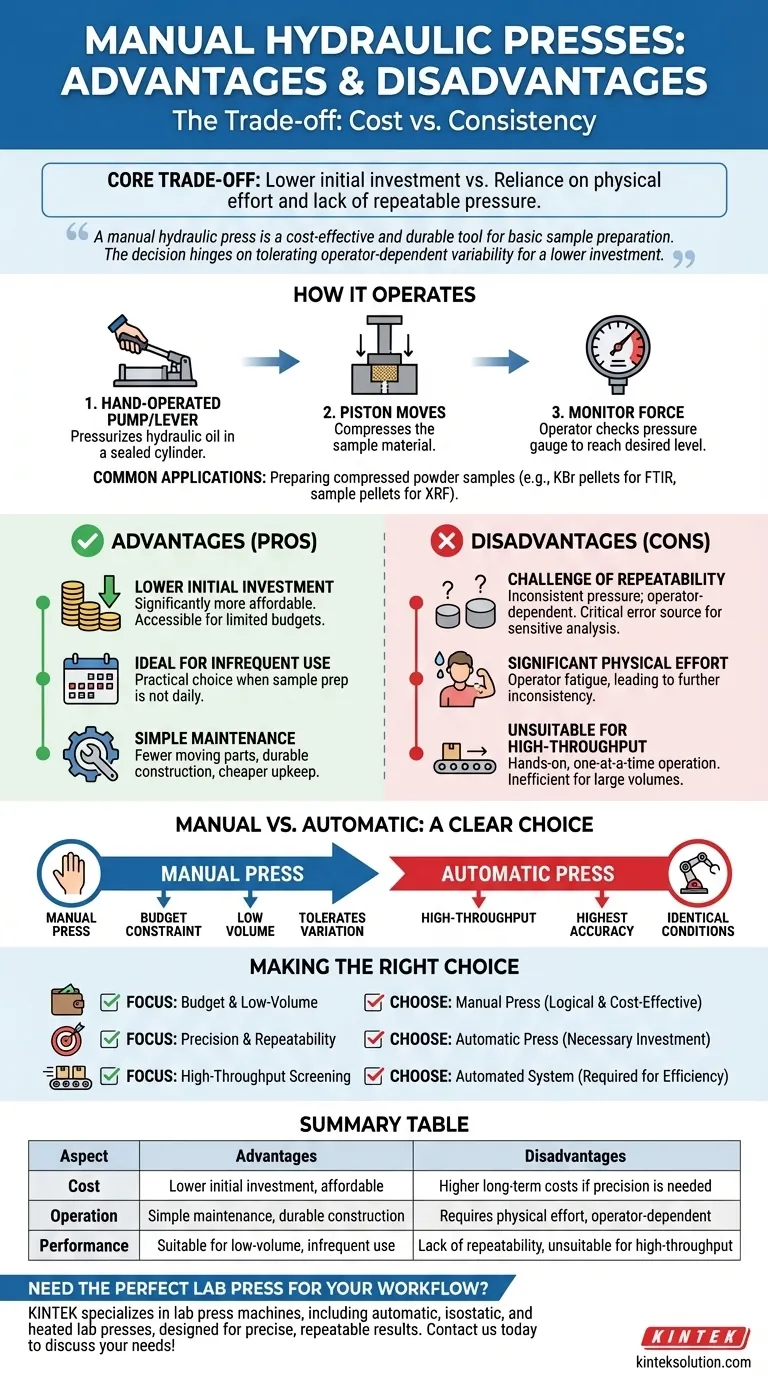
Related Products
- Manual Laboratory Hydraulic Press Lab Pellet Press
- Laboratory Hydraulic Press 2T Lab Pellet Press for KBR FTIR
- Laboratory Hydraulic Press Lab Pellet Press Button Battery Press
- Automatic Laboratory Hydraulic Press Lab Pellet Press Machine
- Manual Heated Hydraulic Lab Press with Integrated Hot Plates Hydraulic Press Machine
People Also Ask
- What are the key features of manual hydraulic pellet presses? Discover Versatile Lab Solutions for Sample Prep
- What are the advantages of using a hydraulic press for pellet production? Achieve Consistent, High-Quality Samples
- How are hydraulic presses used in the preparation of powder mixtures? Achieve Precise Compaction for Accurate Analysis
- What safety features are included in manual hydraulic pellet presses? Essential Mechanisms for Operator and Equipment Protection
- What feature of the hydraulic portable press helps monitor the pellet-making process? Discover the Key to Precise Sample Preparation









